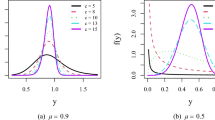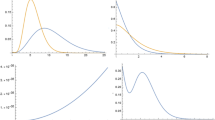Abstract
The Singh–Maddala distribution is very flexible and most widely used for modeling the income, wage, expenditure and wealth distribution of the country. Several mathematical and statistical properties of this distribution (such as quantiles, moments, moment generating function, hazard rate, mean residual lifetime, mean deviation about mean and median, Bonferroni and Lorenz curves and various entropies) are derived. We establish relations for the single and product moments of generalized order statistics from the Singh–Maddala distribution and then we use these results to compute the first four moments and variance of order statistics and record values for sample different sizes for various values of the shape and scale parameters. For this distribution, two characterizing results based on conditional moments of generalized order statistics and recurrence relations for single moments are established. The method of maximum likelihood is adopted for estimating the unknown parameters. For different parameters settings and sample sizes, the various simulation studies are performed and compared to the performance of the Singh–Maddala distribution. An application of the model to a real data set is presented and compared with the fit attained by some other well-known two and three parameters distributions.




Similar content being viewed by others
Change history
23 February 2021
A Correction to this paper has been published: https://doi.org/10.1007/s13198-020-01047-x
References
Akaike H (1974) A new look at the statistical models identification. IEEE Trans Autom Control AC 19:716–723
Arnold BC, Balakrishnan N, Nagaraja HN (1992) A first course in order. Wiley, New York
Balakrishnan N, Cohen AC (1991) Order statistics and inference: estimation methods. Academic, Boston
Bjerkedal T (1960) Acquisition of resistance in guinea pigs infected with different doses of virulent tubercle bacilli. Am J Hyg 72:130–148
Bonferroni CE (1930) Elmenti di statistica generale. Libreria Seber, Firenze
Chandra M, Singpurwalla ND (1978) The Gini index, the Lorenz curve, and the total time on test transforms. Department of Statistics, George Washington University, Washington Unpublished Technical Report
Chandra M, Singpurwalla ND (1981) Relationships between some notions which are common to reliability theory and economics. Math Oper Res 6:113–121
Csörgő M, Gastwirth JL, Zitikis R (1998) Asymptotic confidence bands for the Lorenz and Bonferroni curves based on the empirical Lorenz curve. J Stat Plan Inference 74:65–91
David HA (1981) Order statistics, 2nd edn. Wiley, New York
Doiron DJ, Barrett GF (1996) Inequality in male and female earnings: the role of hours and earnings. Rev Econom Stat 78:410–420
Gail MH, Gastwirth JL (1978) A scale-free goodness-of-t test for the exponential distribution based on the Lorenz curve. J Am Stat Assoc 73:229–243
Gradshteyn IS, Ryzhik IM (2007) Tables of integrals, series of products. Academic, New York
Gupta AK, Nadarajah S (2004) Handbook of beta distribution and its applications. Marcel Dekker, New York
Hart PE (1971) Entropy and other measures of concentration. J R Stat Soc Ser A 134:73–89
Hart PE (1975) Moment distributions in economics: an exposition. J R Stat Soc Ser A 138:423–434
Johnson NL, Kotz S, Balakrishnan N (1995) Continuous univariate distributions, vol 2, 2nd edn. Wiley, New York
Kamps U (1995) A concept of generalized order statistics. B.G. Teubner, Stuttgart
Kim C, Han K (2014) Bayesian estimation of Rayleigh distribution based on generalized order statistics. Appl Math Sci 8:7475–7485
Kotz S, Dorp JR (2004) Beyond beta; other continuous families of distributions with bounded support and applications. World Scientific, New Jersey
Kumar D (2015a) The extended generalized half logistic distribution based on ordered random variables. Tamkang J Math 46:245–256
Kumar D (2015b) Exact moments of generalized order statistics from type II exponentiated log-logistic distribution. Hacet J Math Stat 44:715–733
Kumar D, Khan MI (2012) Recurrence relations for moments of k-th record values from generalized Beta II distribution and a characterization. Selçuk J Appl Math 13:75–82
Kundu D, Howlader H (2010) Bayesian inference and prediction of the inverse Weibull distribution for Type-II censored data. Comput Stat Data Anal 54:1547–1558
Lin GD (1986) On a moment problem. Tohoku Math J 38:595–598
Lorenz MC (1905) Methods of measuring the concentration of wealth. J Am Stat Assoc 9:209–219
McDonld JB (1984) Some generalization functions for the size distribution of income. Econometrica 52:647–663
Moors JJA (1988) A quantile alternative for kurtosis. J Royal Stat Soc Ser D 37:25–32
Nadarajah S, Gupta AK (2004) Generalizations and related univariate distributions. In: A handbook of beta distribution and its applications. New York: Dekker, pp 97–163
Nikitin YY, Tchirina AV (1996) Bahadur efficiency and local optimality of a test for the exponential distribution based on the Gini statistic. J Ital Stat Soc 5:163–175
Schwarz G (1978) Estimating the dimension of a model. Ann Stat 6:421–464
Sen A (1973) On economic inequality. Norton, New York
Shahzad MN, Asghar Z (2013) Parameter estimation of Singh–Maddala distribution by moments. Int J Adv Stat Probab 3:121–131
Singh SK, Maddala GS (1976) A function for size distribution of Incomes. Ecnometrica 44:963–970
Slottje DJ (1989) The structure of earnings and the measurement of income inequality in the US. North-Holland, Amsterdam
Wu SJ, Chen YJ, Chang CT (2007) Statistical inference based on progressively censored samples with random removals from the Burr type XII distribution. J Stat Comput Simul 77:19–27
Acknowledgements
The author is deeply thankful to the editor and the reviewers for their valuable suggestions to improve the quality of paper.
Author information
Authors and Affiliations
Corresponding author
Appendix
Appendix
By differentiating (5.2), the elements of the Fisher information matrix \(I(\varTheta )\) for the parameters (α, β, λ) are:
Rights and permissions
About this article
Cite this article
Kumar, D. The Singh–Maddala distribution: properties and estimation. Int J Syst Assur Eng Manag 8 (Suppl 2), 1297–1311 (2017). https://doi.org/10.1007/s13198-017-0600-1
Received:
Revised:
Published:
Issue Date:
DOI: https://doi.org/10.1007/s13198-017-0600-1
Keywords
- Generalized order statistics
- Order statistics
- Record values
- Single moments
- Product moments
- Recurrence relations
- Singh–Maddala distribution
- Characterization
- Estimation




